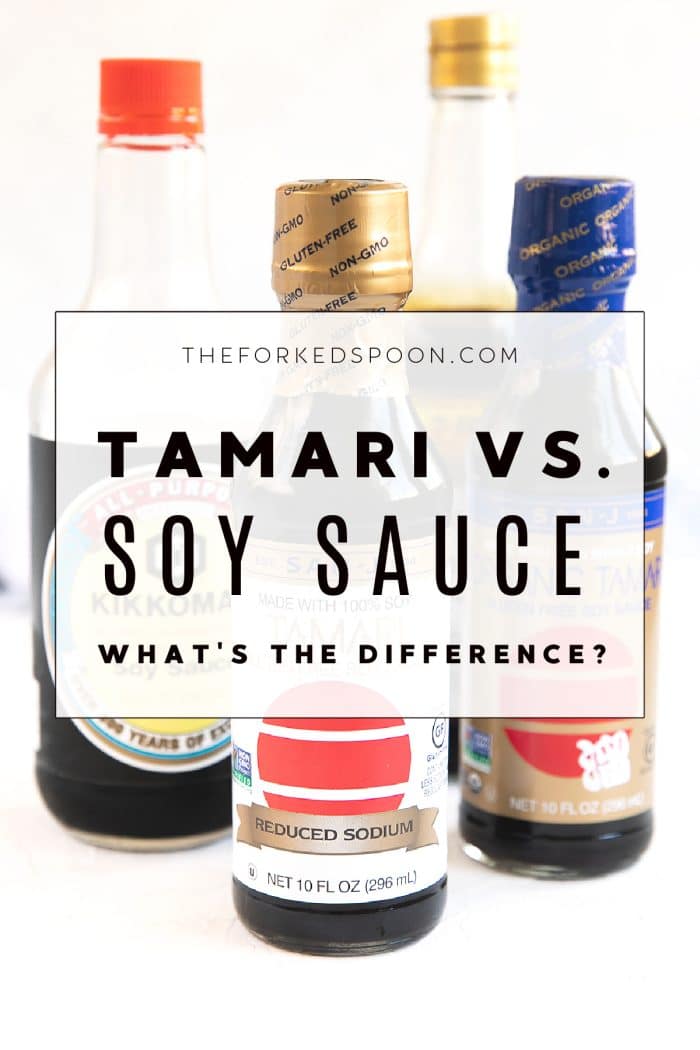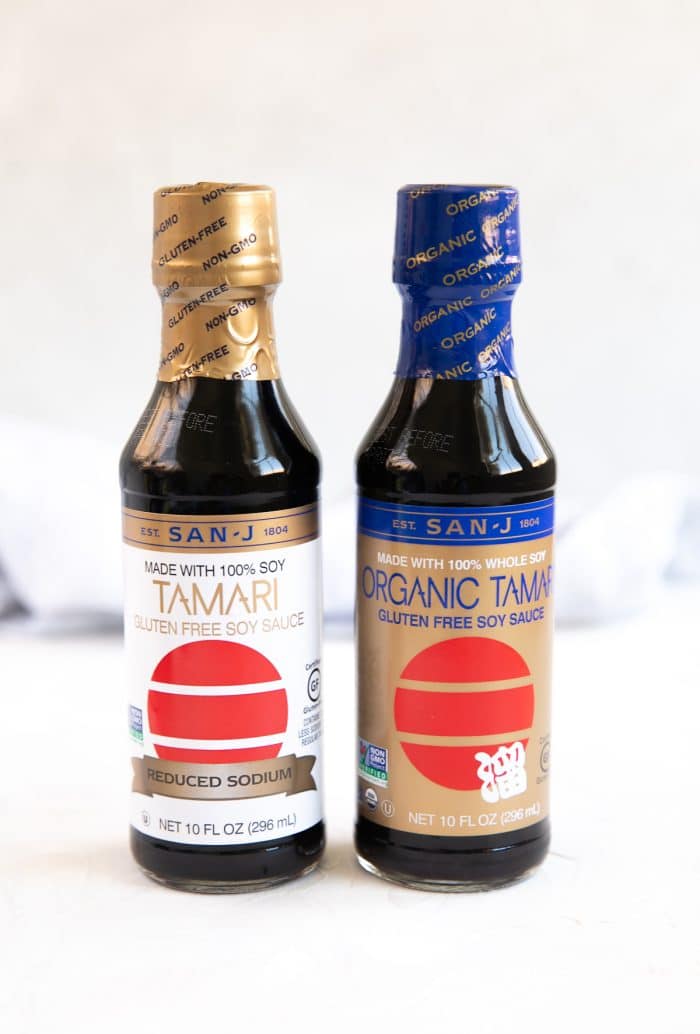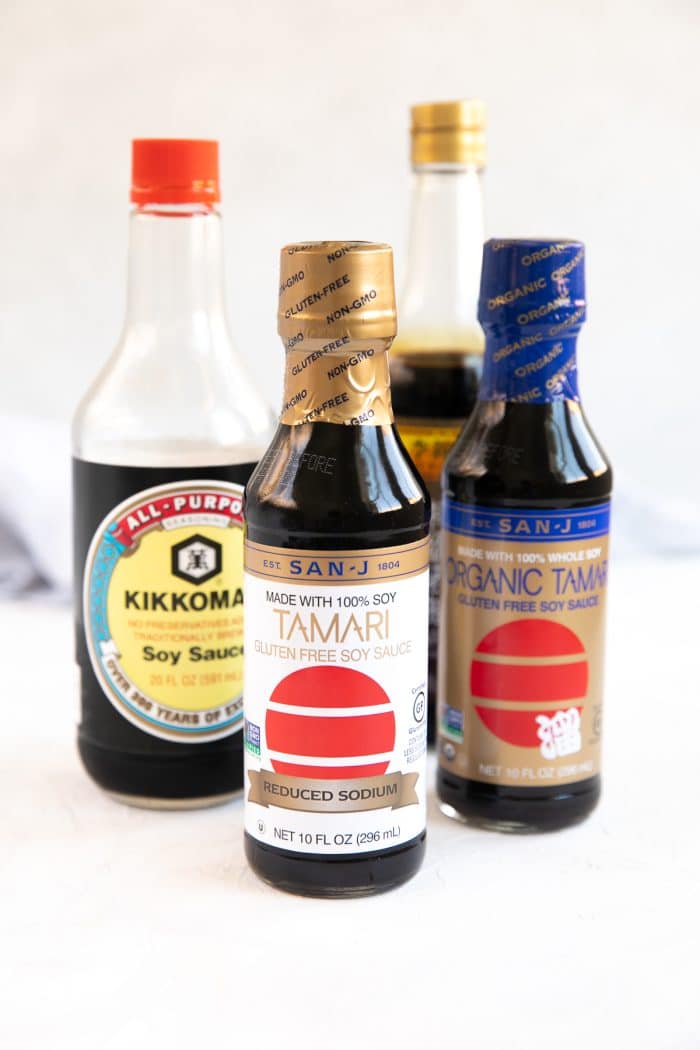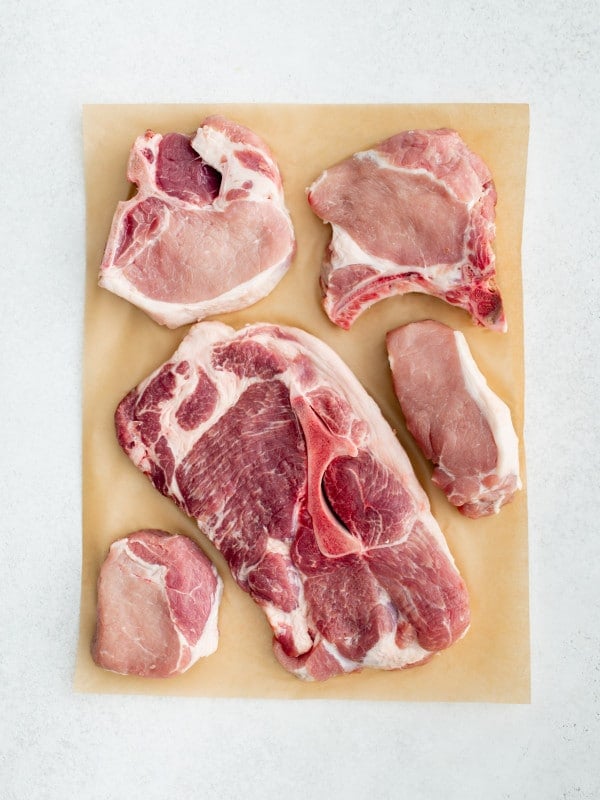This post may contain affiliate links. Please read our disclosure policy.
Every culture brings a different signature sauce to the world’s table. From the zesty chimichurri sauce recipes of South America to the rich continental roux of France, there is a sauce that fits every culinary occasion. Here’s the difference between Tamari vs. Soy Sauce.

Here at The Forked Spoon, we have a deep appreciation for the sauces of the world because they add a whole new dimension of flavor and vibrancy to our dishes. Many sauces, like our ten-minute Tzatziki, require only a few ingredients to elevate your entire dinner.
Today we’re comparing two well known Asian sauces that have been going head-to-head for a VERY long time: Tamari vs. Soy Sauce. Recently, Tamari has come into the spotlight due to its status as a gluten-free alternative.
While these two legendary condiments may share some salty similarities on the surface, you may be surprised to learn that their histories, production methods, and applications are very distinct.
Let’s check out the differences between Tamari and Soy Sauce and talk about how you can best equip each one for your culinary arsenal.
Soy Sauce vs. Tamari: Key Attributes
First of all, both of these sauces are derived from soybeans, so it is a bit misleading to call one Soy Sauce while the other is given a different name.
The key factor you need to keep in mind when thinking about Soy Sauce vs. Tamari is the presence or absence of wheat in the production process.
That bottle of standard all-purpose soy sauce in your cabinet contains wheat or another grain, which was fermented along with soybeans before the dark, salty liquid was pressed and strained out of the mixture.
Tamari, on the other hand, comes from 100% fermented soybeans, which gives it that one-of-a-kind “Umami” flavor reminiscent of roasted meats and rich cheese. The pure soy paste it comes from is known as Miso in Japan, which has its own unique uses.
Therefore many soy sauce labels say something like “naturally brewed” since the production process takes over two years and involves many steps similar to that of beer or wine. Avoid bottles that do not mention brewing because they are likely loaded with chemicals and miss the essence of this wonderful product.
In a blind taste test of Soy Sauce vs. Tamari, you’ll want to focus on the consistency and the saltiness of the sauces to tell the difference. Soy Sauce will always be thinner and saltier, while Tamari will have a thicker and less salty flavor.
History
We aren’t exaggerating when we say this is an ancient sauce rivalry. We have to go back to the Analects of Confucius, published around 300 BC, to identify when the Chinese first recorded the use of soybean fermentation for cooking and preserving.
According to the online Soy Info Center, early Chinese soy sauces were known as Chiyou and Jiangyou, which had thicker and more pasty properties than the liquid sauce we know today.
Soybeans, referred to as nuggets, remained in the mixture and resembled raisins. The product was originally used to preserve meat and vegetables, which was a necessary process before the advent of modern refrigeration.
Numerous accounts of soy paste and oil extracts can be found in the following centuries, as historians around the world found terms like Soyo, Soya and Shoyu sprinkled throughout commerce documentation and cookbooks.
Soy sauce was mentioned as early as 683 AD in Korea, and 775 AD in Japan and each culture put its own twists on the Chinese export.
Around 1850, Tamari became a staple of culinary life in Japan, according to a soy sauce history online resource. One record shows that more than 18,000 liters of Tamari were sent from the countryside to the city on an annual basis!
While Soy Sauce and Tamari exploded in popularity throughout the centuries, it took some time before these products made their mark on the West.
It wasn’t until 1679 that English philosopher John Locke sampled and wrote about a Japanese sauce he called Saio. Since then, countless Western writers have tapped into the magic of salty soy flavors and brought worldwide consumption to new levels.
Today, the soy sauce market is booming, with an annual growth rate of 5.6%, according to a recent press release from PR Newswire. By 2025, the market is expected to reach $5.6 Billion, with production rising across industrialized and developing nations alike.
Nutrition
Everybody loves the taste and versatility of soy sauce and tamari, but which product packs more nutritional value per drop?
Calorie-wise, neither product is a real diet-buster. One tablespoon of Tamari contains 15 calories, while one tablespoon of traditionally brewed soy sauce has only 10.
However, each sauce is less innocent when it comes to sodium. Both products can contain between 900 and 1000 milligrams of sodium, ranging between 35% and 40% of your total daily value.
For anyone looking to cut back on the salt, have a look at low-sodium soy sauce and tamari alternatives. They can still be very effective in elevating your dishes.
Another key factor to consider in the Soy Sauce vs. Tamari debate is gluten.
According to an article from the New Hope Network, more than 40 million Americans report some level of gluten sensitivity, with another 1 million people having an official celiac diagnosis, which prohibits gluten completely.
Although gluten-free soy sauces do exist, you’ll be missing out on the authentic zesty flavor that comes from the presence of wheat in the fermentation process.
Paleo Warriors and the Ketogenic Crew will also want to avoid standard soy sauce due to the inclusion of grains. While a few drops of sauce may not be as detrimental as a loaf of bread, even a small amount of wheat can throw off a strict diet.
Researchers have been uncovering other great health benefits of soy sauce and its varietals, according to Medical Life Sciences News. Protection against cancer, anti-inflammatory properties, and anti-hypertension are just a few of the added bonuses.
One last thing to keep in mind is that Tamari tends to contain fewer additives than traditionally brewed soy sauce because the production methods are more strict. If you are keen on avoiding chemicals, the Japanese Tamari may be your pick.
How to Use
There are countless recipes that call for soy sauce or tamari, but both sauces can stand on their own. Just a few dashes can bring out amazing new flavors from meat and vegetables, and both are popular dipping sauces for sushi and dumplings.
We believe that tamari is actually a better bet for dunking Maki rolls and Gyoza, due to its thicker consistency and lower salt content. You want the sauce to adhere to the item without overpowering the delicate flavors of the fish or meat.
Tamari is also our go-to for roasting chickpeas and almonds at home. The rich umami flavor really brings out a new dimension of these not-so-interesting legumes.
For many more complex sauces, traditionally brewed soy is the star of the show. We recommend making a big batch of easy teriyaki sauce to keep in the fridge and use anytime to marinate or dip your favorite snacks!
Soy sauce and tamari can also be a stealthy addition to cake and cookie mixes, salad dressings, and bread. It’s smart to keep a few different types in your pantry (light, dark, and low-sodium) to fit the occasion.
When diving into Asian home-cooking, you’ll always want to keep soy sauce and tamari close by!
Chicken stir-fry and bok choy are one of our favorite combos of protein and greens, which takes on a whole new personality with soy sauce marinade. Even picky eaters will enjoy this super-healthy dish thanks to the superb seasoning.
Want to introduce even more dark leafy greens to the family? You’ll need some soy sauce to make our Chinese garlic broccoli, which delivers huge amounts of nutrition and flavor in less than fifteen minutes.
If you don’t think the kids are ready to take on those intense east-Asian flavors, ease into things with some honey soy chicken thighs. They are fast and easy to prepare and always knock it out of the park at the dinner table.
Up for more of a challenge? Or just want an excuse to pack your pantry with funky new ingredients like oyster sauce and fish sauce? Take on our Pad See Ew recipe and enjoy this classic “fried soy sauce” specialty from Thailand.
Once your cabinet is loaded up with a full spectrum of soy sauce and tamari, you can start improvising with your own smokey, salty creations!
Conclusions
The Soy Sauce vs. Tamari debate has been heated for many centuries, but it wouldn’t be right to declare a definitive winner! Each sauce has its own pros and cons, both in the kitchen and from a health perspective.
We can’t argue that traditionally brewed soy sauce packs that undeniable punch of distinct salty flavor we all know and love, but tamari may be a better choice when dealing with lighter and more delicate ingredients.
Next time you’re at the store, grab a few different bottles, and start harnessing the power of these magnificent soy flavors!
















I once bought a large amount of Tamari Sauce at Erehwon in Boston when it was there long ago, and it was thicker than anything I have seen today, I just bought Tamari by Sanjay from Amazon and it seems pretty thin. Any advice?
You will probably have to go to an Asian Super Market and tilt the Tamari bottles to try to judge their sauce’s thickness 🙂